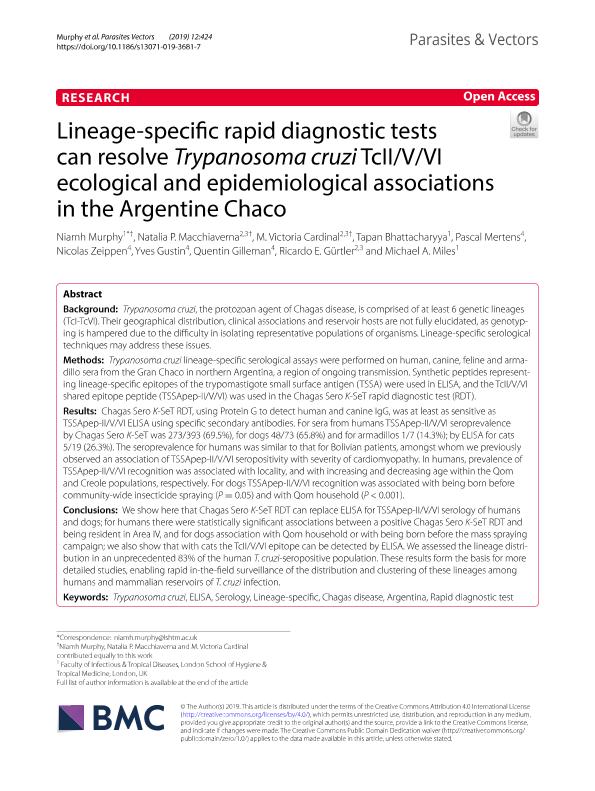Mostrar el registro sencillo del ítem
dc.contributor.author
Murphy, Niamh
dc.contributor.author
Macchiaverna, Natalia Paula

dc.contributor.author
Cardinal, Marta Victoria

dc.contributor.author
Bhattacharyya, Tapan

dc.contributor.author
Mertens, Pascal
dc.contributor.author
Zeippen, Nicolas
dc.contributor.author
Gustin, Yves
dc.contributor.author
Gilleman, Quentin
dc.contributor.author
Gurtler, Ricardo Esteban

dc.contributor.author
Miles, Michael A.

dc.date.available
2022-07-29T17:00:18Z
dc.date.issued
2019-09
dc.identifier.citation
Murphy, Niamh; Macchiaverna, Natalia Paula; Cardinal, Marta Victoria; Bhattacharyya, Tapan; Mertens, Pascal; et al.; Lineage-specific rapid diagnostic tests can resolve Trypanosoma cruzi TcII/V/VI ecological and epidemiological associations in the Argentine Chaco; BioMed Central; Parasites and Vectors; 12; 1; 9-2019; 1-11
dc.identifier.issn
1756-3305
dc.identifier.uri
http://hdl.handle.net/11336/163561
dc.description.abstract
Background: Trypanosoma cruzi, the protozoan agent of Chagas disease, is comprised of at least 6 genetic lineages (TcI-TcVI). Their geographical distribution, clinical associations and reservoir hosts are not fully elucidated, as genotyping is hampered due to the difficulty in isolating representative populations of organisms. Lineage-specific serological techniques may address these issues. Methods: Trypanosoma cruzi lineage-specific serological assays were performed on human, canine, feline and armadillo sera from the Gran Chaco in northern Argentina, a region of ongoing transmission. Synthetic peptides representing lineage-specific epitopes of the trypomastigote small surface antigen (TSSA) were used in ELISA, and the TcII/V/VI shared epitope peptide (TSSApep-II/V/VI) was used in the Chagas Sero K-SeT rapid diagnostic test (RDT). Results: Chagas Sero K-SeT RDT, using Protein G to detect human and canine IgG, was at least as sensitive as TSSApep-II/V/VI ELISA using specific secondary antibodies. For sera from humans TSSApep-II/V/VI seroprevalence by Chagas Sero K-SeT was 273/393 (69.5%), for dogs 48/73 (65.8%) and for armadillos 1/7 (14.3%); by ELISA for cats 5/19 (26.3%). The seroprevalence for humans was similar to that for Bolivian patients, amongst whom we previously observed an association of TSSApep-II/V/VI seropositivity with severity of cardiomyopathy. In humans, prevalence of TSSApep-II/V/VI recognition was associated with locality, and with increasing and decreasing age within the Qom and Creole populations, respectively. For dogs TSSApep-II/V/VI recognition was associated with being born before community-wide insecticide spraying (P = 0.05) and with Qom household (P < 0.001). Conclusions: We show here that Chagas Sero K-SeT RDT can replace ELISA for TSSApep-II/V/VI serology of humans and dogs; for humans there were statistically significant associations between a positive Chagas Sero K-SeT RDT and being resident in Area IV, and for dogs association with Qom household or with being born before the mass spraying campaign; we also show that with cats the TcII/V/VI epitope can be detected by ELISA. We assessed the lineage distribution in an unprecedented 83% of the human T. cruzi-seropositive population. These results form the basis for more detailed studies, enabling rapid in-the-field surveillance of the distribution and clustering of these lineages among humans and mammalian reservoirs of T. cruzi infection.
dc.format
application/pdf
dc.language.iso
eng
dc.publisher
BioMed Central

dc.rights
info:eu-repo/semantics/openAccess
dc.rights.uri
https://creativecommons.org/licenses/by/2.5/ar/
dc.subject
ARGENTINA
dc.subject
CHAGAS DISEASE
dc.subject
ELISA
dc.subject
LINEAGE-SPECIFIC
dc.subject
RAPID DIAGNOSTIC TEST
dc.subject
SEROLOGY
dc.subject
TRYPANOSOMA CRUZI
dc.subject.classification
Epidemiología

dc.subject.classification
Ciencias de la Salud

dc.subject.classification
CIENCIAS MÉDICAS Y DE LA SALUD

dc.title
Lineage-specific rapid diagnostic tests can resolve Trypanosoma cruzi TcII/V/VI ecological and epidemiological associations in the Argentine Chaco
dc.type
info:eu-repo/semantics/article
dc.type
info:ar-repo/semantics/artículo
dc.type
info:eu-repo/semantics/publishedVersion
dc.date.updated
2020-11-20T14:47:06Z
dc.journal.volume
12
dc.journal.number
1
dc.journal.pagination
1-11
dc.journal.pais
Reino Unido

dc.journal.ciudad
Londres
dc.description.fil
Fil: Murphy, Niamh. London School of Hygiene & Tropical Medicine; Reino Unido
dc.description.fil
Fil: Macchiaverna, Natalia Paula. Consejo Nacional de Investigaciones Científicas y Técnicas. Oficina de Coordinación Administrativa Ciudad Universitaria. Instituto de Ecología, Genética y Evolución de Buenos Aires. Universidad de Buenos Aires. Facultad de Ciencias Exactas y Naturales. Instituto de Ecología, Genética y Evolución de Buenos Aires; Argentina
dc.description.fil
Fil: Cardinal, Marta Victoria. Consejo Nacional de Investigaciones Científicas y Técnicas. Oficina de Coordinación Administrativa Ciudad Universitaria. Instituto de Ecología, Genética y Evolución de Buenos Aires. Universidad de Buenos Aires. Facultad de Ciencias Exactas y Naturales. Instituto de Ecología, Genética y Evolución de Buenos Aires; Argentina
dc.description.fil
Fil: Bhattacharyya, Tapan. London School of Hygiene & Tropical Medicine; Reino Unido
dc.description.fil
Fil: Mertens, Pascal. No especifíca;
dc.description.fil
Fil: Zeippen, Nicolas. No especifíca;
dc.description.fil
Fil: Gustin, Yves. No especifíca;
dc.description.fil
Fil: Gilleman, Quentin. No especifíca;
dc.description.fil
Fil: Gurtler, Ricardo Esteban. Consejo Nacional de Investigaciones Científicas y Técnicas. Oficina de Coordinación Administrativa Ciudad Universitaria. Instituto de Ecología, Genética y Evolución de Buenos Aires. Universidad de Buenos Aires. Facultad de Ciencias Exactas y Naturales. Instituto de Ecología, Genética y Evolución de Buenos Aires; Argentina
dc.description.fil
Fil: Miles, Michael A.. London School Of Hygiene & Tropical Medicine; Reino Unido
dc.journal.title
Parasites and Vectors

dc.relation.alternativeid
info:eu-repo/semantics/altIdentifier/url/https://parasitesandvectors.biomedcentral.com/articles/10.1186/s13071-019-3681-7
dc.relation.alternativeid
info:eu-repo/semantics/altIdentifier/doi/http://dx.doi.org/10.1186/s13071-019-3681-7
Archivos asociados
